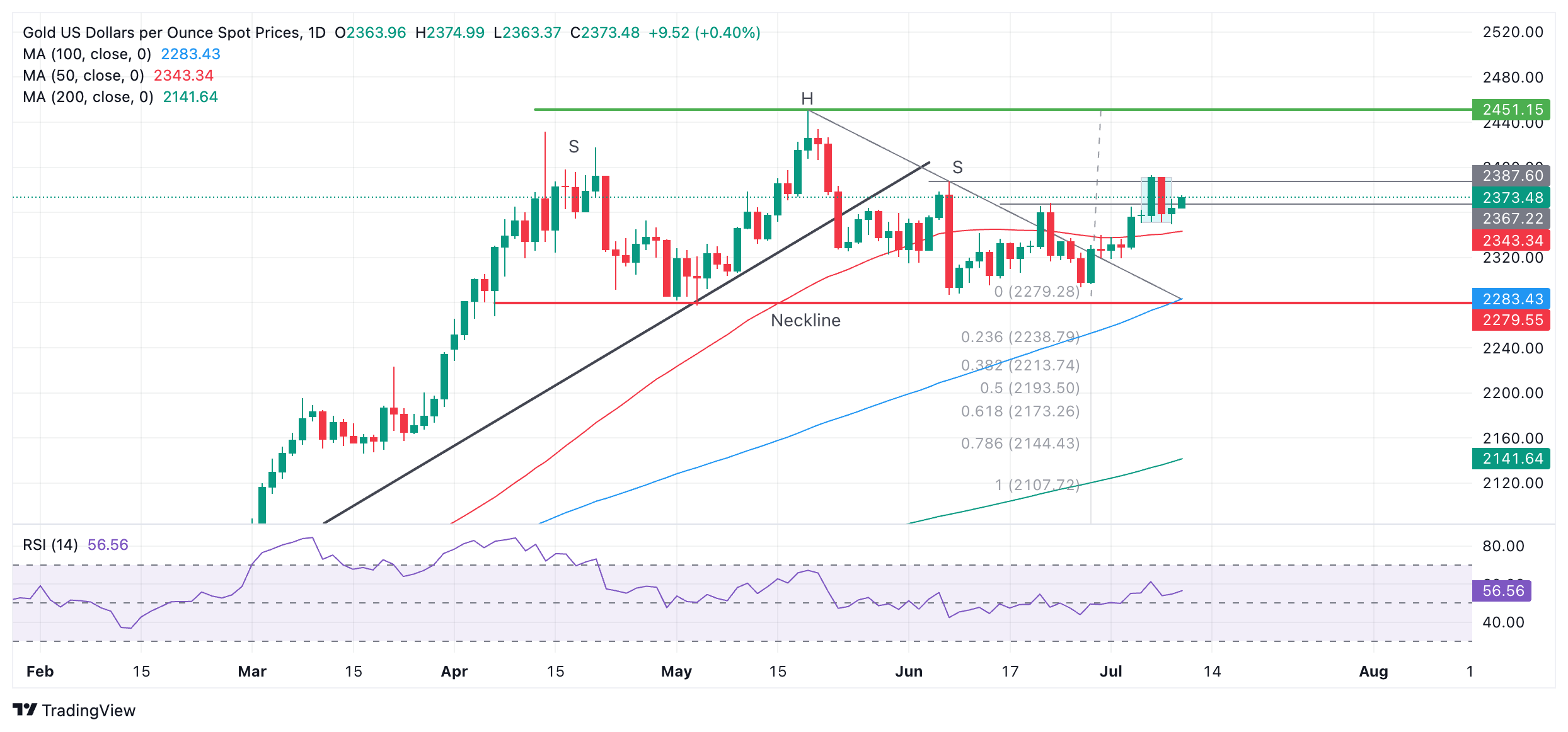- Jerome Powell signals that the Fed is considering a rate cut, but is too shy to give a date.
- Uncertainty reduces volatility for the interest rate-sensitive precious metal.
- Gold rises as global central bank buying remains buoyant despite PBoC absence.
Gold (XAU/USD) is higher on Wednesday, continuing its recovery after the PBoC-related sell-off on Monday.
This comes after data emerged showing that global central bank demand for gold remains buoyant. This has balanced out the negative impact of the news that the largest consumer of gold, the People’s Bank of China (PBoC), stopped buying the precious metal in June, extending its parsimony for another month after it also closed its wallet in May following an 18-month buying spree.
Gold rises despite Powell’s reluctance to name a date
Gold dismissed Federal Reserve (Fed) Chairman Jerome Powell’s testimony before the Senate Banking Committee on Tuesday, in which he refused to give a date for a first interest rate cut, saying instead that the Fed would take a data-dependent approach to interest rates.
Investors were hoping for more concrete details on when the Fed would cut interest rates, and Powell’s quiet retreat should have weakened Gold more than it did. The reason for this is that delays in rate cuts could mean borrowing costs remain elevated for longer, which is negative for Gold as it keeps the opportunity cost of holding the precious metal high. Gold is a non-interest bearing asset, making it less attractive to investors if they can earn higher interest elsewhere.
At the same time, Powell made some statements that acted as an antidote. For example, he acknowledged that progress had been made on inflation and ruled out the possibility of rate hikes. He also said that there was a balance of risks between waiting too long (to cut interest rates) or acting too soon, suggesting a finely balanced situation.
Gold remains higher on news that other central banks are buying
Gold is maintaining its luster on Wednesday, trading in the $2,370 area. The yellow metal is finding bullish momentum after it emerged that despite the PBoC stopping adding to its reserves, other major central banks were still buying substantial amounts of gold.
“Other central banks continue to participate, with the Indian central bank purchasing over nine tonnes of gold in June, the National Bank of Poland increasing its gold reserves by four tonnes and the Czech National Bank showing that its gold reserves increased by around two tonnes in June. With these central banks continuing to build gold positions, it is quite evident that the official sector is much broader than just the PBoC,” said Bert Melek, Head of Commodity Strategy at TD Securities.
In short, China’s absence from the market is unlikely to prevent the commodity from rising to TD’s target of $2,475 in the first quarter of 2025, according to TD’s Malek.
Technical Analysis: Gold continues its slow recovery
Gold is rallying for the second day in a row after forming a two-bar bearish reversal pattern (green shaded rectangle in the chart below) at the top of the early July move. This pattern forms after a long green up day followed by a long red down day of similar length and size. It may be a signal of a short-term reversal.
XAU/USD Daily Chart
The outlook is uncertain. There is a risk that Gold could retrace to the 50-day simple moving average (SMA) at $2,343.
That said, the break above the downtrend line on June 27 turned the tables for the precious metal, establishing a more bullish outlook.
If Gold breaks above Friday’s peak of $2,393, it will continue the sequence of higher highs and likely unlock the next target at the all-time high of $2,451.
The bearish Head and Shoulders (H&S) pattern that formed from April to June has been invalidated by the recent rally. However, there is still a chance, albeit much smaller, that a more complex top pattern has formed in its place.
If a complex pattern has formed instead of the H&S, and price breaks below the pattern’s neckline at $2,279, a downside reversal may still be possible with a conservative target at $2,171, the ratio of 0.618 of the pattern’s height extrapolated to the downside.
The trend is now sideways in both the short and medium term. In the long term, Gold remains in an uptrend.
Gold FAQs
Gold has played a pivotal role in human history as it has been widely used as a store of value and a medium of exchange. Today, apart from its luster and use for jewelry, the precious metal is considered a safe haven asset, meaning it is considered a good investment in turbulent times. Gold is also considered a hedge against inflation and currency depreciation as it is not dependent on any particular issuer or government.
Central banks are the largest holders of gold. In their aim to support their currencies in turbulent times, central banks tend to diversify their reserves and buy gold to improve the perception of the strength of the economy and the currency. High gold reserves can be a source of confidence in a country’s solvency. Central banks added 1,136 tonnes of gold worth about $70 billion to their reserves in 2022, according to data from the World Gold Council. This is the largest annual purchase on record. Central banks in emerging economies such as China, India and Turkey are rapidly increasing their gold reserves.
Gold has an inverse correlation with the US Dollar and US Treasury bonds, which are the main reserve and safe haven assets. When the Dollar depreciates, the price of Gold tends to rise, allowing investors and central banks to diversify their assets in turbulent times. Gold is also inversely correlated with risk assets. A rally in the stock market tends to weaken the price of Gold, while sell-offs in riskier markets tend to favor the precious metal.
Gold prices can move due to a wide range of factors. Geopolitical instability or fears of a deep recession can cause the price of Gold to rise rapidly due to its status as a safe haven asset. As a non-yielding asset, Gold prices tend to rise when interest rates fall, while rising money prices often weigh down the yellow metal. Still, most of the moves depend on how the US Dollar (USD) performs, as the asset is priced in dollars (XAU/USD). A strong Dollar tends to keep Gold prices in check, while a weaker Dollar is likely to push Gold prices higher.
Source: Fx Street
I am Joshua Winder, a senior-level journalist and editor at World Stock Market. I specialize in covering news related to the stock market and economic trends. With more than 8 years of experience in this field, I have become an expert in financial reporting.







